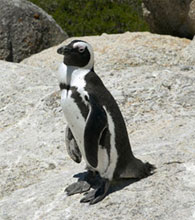

In order to survive, plants and animals have traits or adaptations suited to their environment. For example, humans can place a penguin in a zoo in the United States and provide an appropriate environment, but if the penguin were to escape from the zoo, it would be unlikely to survive long in the wild. The penguin does not have the adaptations it would need in order to survive and reproduce in this foreign environment.
Organisms cannot decide to adapt to changes in the environment. Adaptations are passed, generation to generation, through the genes. Organisms with genetic traits that are advantageous to the organisms’ survival in an environment will survive, reproduce, and pass the adventurous trait on their offspring. This process is known as natural selection.
Let’s look at an example of natural selection.
![]() Click on the Next button to begin the animation.
Click on the Next button to begin the animation.
Many times, adaptations are results of genetic mutations that occur during an organism's development. A mutation is simply a change in DNA.
![]() Watch this video to learn more about natural selection and mutations.
Watch this video to learn more about natural selection and mutations.
Source: Learn Biology: Natural Selection, Mahalo, YouTube